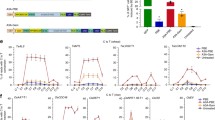Abstract
The Cas9 protein fused with a cytidine deaminase can induce C to T substitutions at a specific site when directed by a guide RNA. Here, we compared the substitution activity and the substitution range of two base-editing systems, APOBEC1-nCas9 and nCas9-PmCDA1, in the protoplasts of Glycine max, Brassica napus, and Nicotiana tabacum. To prevent unwanted nucleotide substitution, we manipulated the length of guide RNA and found the change of nucleotide substitution activity in the target window of nCAS9-PmCDA1. Based on these results, the specific C to T conversion in the acetolactate synthase gene of N. tabacum was induced to generate herbicide-resistant plants. During the screening of herbicide-resistant plants, we found that ubiquitin promoter-driven base-editor system was much efficient than 35S promoter-driven base-editor system. This study provides guidelines on which a base editor to use and describes how to fine-tune a guide RNA for precise substitutions in plants.






Similar content being viewed by others
References
Dominguez AA, Lim WA, Qi LS (2015) Beyond editing: repurposing CRISPR–Cas9 for precision genome regulation and interrogation. Nat Rev Mol Cell Biol 17:5–15
Doudna JA, Charpentier E (2014) The new frontier of genome engineering with CRISPR-Cas9. Science 346:1258096
Finer JJ, Nagasawa A (1988) Development of an embryogenic suspension culture of soybean (Glycine max Merrill.). Plant Cell Tissue Organ Cult 15:125–136
Gutschner T, Haemmerle M, Genovese G et al (2016) Post-translational regulation of CAS9 during G1 enhances homology-directed repair. Cell Rep 14:1555–1566
Horsch RB, Fry JE, Hoffmann NL et al (1985) A simple and general method for hybridization revealed the expected. Science 227:1229–1231
Hsu PD, Lander ES, Zhang F (2014) Development and applications of CRISPR-Cas9 for genome engineering. Cell 157:1262–1278
Jie E-Y, Kim S-W, Jang H-R et al (2011) Myo-inositol increases the plating efficiency of protoplast derived from cotyledon of cabbage (Brassica oleracea var. capitata). J Plant Biotechnol 38:69–76
Jinek M, Chylinski K, Fonfara I et al (2012) A programmable dual-RNA-guided DNA endonuclease in adaptive bacterial immunity. Science 337:816–821
Kim H, Kim J-S (2014) A guide to genome engineering with programmable nucleases. Nat Rev Genet 15:321–334
Kim Kim ST, Ryu J et al (2016) A simple, flexible and high-throughput cloning system for plant genome editing via CRISPR-Cas system. J Integr Plant Biol 58:705–712
Komor AC, Kim YB, Packer MS et al (2016) Programmable editing of a target base in genomic DNA without double-stranded DNA cleavage. Nature 61:5985–5991
Lee KY, Townsend J, Tepperman J et al (1988) The molecular basis of sulfonylurea herbicide resistance in tobacco. EMBO J 7:1241–1248
Li J, Sun Y, Du J et al (2017) Generation of targeted point mutations in rice by a modified CRISPR/Cas9 system. Mol Plant 10(3):526–529
Liu XS, Wu H, Ji X et al (2016) Editing DNA methylation in the mammalian genome. Cell 167:233–247.e17
Lu Y, Zhu J (2016) Precise editing of a target base in the rice genome using a modified CRISPR/Cas9 system. Mol Plant 10:523–525
McCourt JA, Duggleby RG (2006) Acetohydroxyacid synthase and its role in the biosynthetic pathway for branched-chain amino acids. Amino Acids 31:173–210
Nishida K, Arazoe T, Yachie N et al (2016) Targeted nucleotide editing using hybrid prokaryotic and vertebrate adaptive immune systems. Science 353(6305):aaf8729
Ordon J, Bressan M, Kretschmer C, Dall'Osto L, Marillonnet S, Bassi R, Stuttmann J (2019) Optimized Cas9 expression systems for highly efficient Arabidopsis genome editing facilitate isolation of complex alleles in a single generation. Funct Integr Genomics. https://doi.org/10.1007/s10142-019-00665-4
Park J, Lim K, Kim JS, Bae S (2017) Cas-analyzer: an online tool for assessing genome editing results using NGS data. Bioinformatics 33:286–288
Powles SB, Yu Q (2010) Evolution in action: plants resistant to herbicides. Annu Rev Plant Biol 61:317–347
Shimatani Z, Kashojiya S, Takayama M et al (2017) Targeted base editing in rice and tomato using a CRISPR-Cas9 cytidine deaminase fusion. Nat Biotechnol 35:441–443
Sierro N, Battey JND, Ouadi S et al (2014) The tobacco genome sequence and its comparison with those of tomato and potato. Nat Commun 5:1–9
Sun Y, Zhang X, Wu C et al (2016) Engineering herbicide-resistant rice plants through CRISPR/Cas9-mediated homologous recombination of acetolactate synthase. Mol Plant 9:628–631
Tian S, Jiang L, Cui X et al (2018) Engineering herbicide-resistant watermelon variety through CRISPR/Cas9-mediated base-editing. Plant Cell Rep 37:1353–1356
Townsend JA, Wright DA, Winfrey RJ et al (2009) High-frequency modification of plant genes using engineered zinc-finger nucleases. Nature 459:442–445
Wang L, Xue W, Yan L et al (2017) Enhanced base editing by co-expression of free uracil DNA glycosylase inhibitor. Cell Res 27:1289–1292
Yoo S-D, Cho Y-H, Sheen J (2007) Arabidopsis mesophyll protoplasts: a versatile cell system for transient gene expression analysis. Nat Protoc 2:1565–1572
Zong Y, Wang Y, Li C et al (2017) Precise base editing in rice, wheat and maize with a Cas9-cytidine deaminase fusion. Nat Biotechnol 35:438–440
Acknowledgements
B-CK, JW, S-TK, J-SK, S-GK designed experiments; B-CK, JW, S-JB performed plant transformation and tissue culture; B-CK, MC made vector constructs; B-CK, S-TK analyzed deep sequencing data; B-CK and S-GK mainly wrote the manuscript; J-SK, S-GK contributed to the revision of the manuscript and oversaw the project. This work was supported by Institute for Basic Science (IBS-R021-D1) and the Next-Generation BioGreen 21 Program (PJ01322603 and PJ01311601) provided by the Rural Development Administration to S-GK. We thank Emily Wheeler, Boston, for editorial assistance and Hyeran Kim for critical discussion.
Author information
Authors and Affiliations
Corresponding authors
Ethics declarations
Conflict of interest
The authors declare that they have no competing interests.
Additional information
Publisher's Note
Springer Nature remains neutral with regard to jurisdictional claims in published maps and institutional affiliations.
Electronic supplementary material
Below is the link to the electronic supplementary material.
Rights and permissions
About this article
Cite this article
Kang, BC., Woo, J.W., Kim, ST. et al. Guidelines for C to T base editing in plants: base-editing window, guide RNA length, and efficient promoter. Plant Biotechnol Rep 13, 533–541 (2019). https://doi.org/10.1007/s11816-019-00572-x
Received:
Accepted:
Published:
Issue Date:
DOI: https://doi.org/10.1007/s11816-019-00572-x




